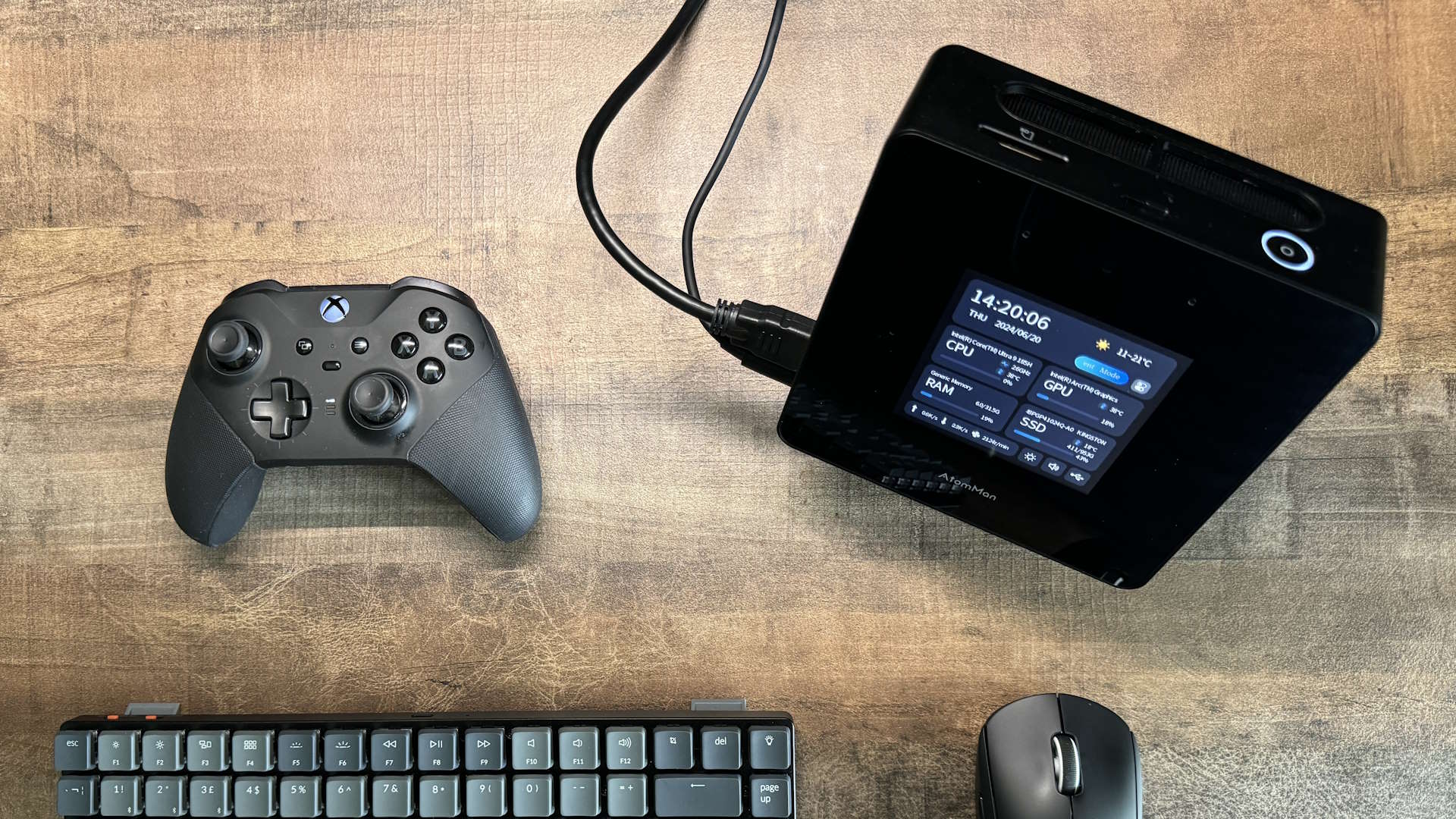
A powerful mini PC with cutting-edge mobile tech, outstanding cooling, but oddly mercurial graphics performance.
When it comes to ultra-compact gaming performance, the AtomMan X7 TI from Minisforum is something of an enigma. On the one hand, it features Intel’s current top-tier mobile chip, the Core Ultra 9 185H, joined at the hip with what can rightly be considered a step-change in the company’s integrated graphics processors. Intel Iris Xe is dead: long live Intel ARC.
In many games, it proves to be a highly competent APU double-act, capable of matching and even trouncing AMD Ryzen/Radeon duets in some situations.
On the other, there seems to be no rhyme or reason as to which games it will flatter, which it will not, and which will be subjected to an Uzi-spray of 1%-low stutters, rendering them unplayable. It’s baffling. But let’s take a step back for a moment and look at the whole package.
The AtomMan X7 Ti is a touch larger than most of its mini-PC stablemates, but only a touch. You can bag it preloaded with 32 GB DDR5 and a 1 TB M.2 drive, or opt for the barebones version. That’s the better deal here, as it’ll save you a couple of hundred on the unit cost in order to shop around for cheaper RAM and storage.
(Image credit: Future)
CPU: Intel Core Ultra 9 185H
iGPU: Intel ARC
Memory: 0GB/32GB DDR5 5600
Storage: 0TB/1TB PCI-E Gen4 M.2 SSD
Wireless: Wi-Fi 7, Bluetooth 5.3
I/O: 2x USB4C Thunderbolt, 2x USB 3.2, 1x USB 2.0, SD card reader, 3.5mm audio, 2x 5G LAN, 1x HDMI 2.1, 2x DP 2.0
Price: £829/$849 fully loaded, £649/$669 barebones
The case features a tidy design with a glossy 4-inch touchscreen adorning the top (which becomes the face, if you choose to use the thoughtfully-supplied vertical aluminium stand). The screen displays comprehensive hardware-monitoring for the CPU, GPU, RAM, storage, network traffic, and fan, enabling you to adjust the screen brightness and system volume, switch the display language, enumerate all the devices you have plugged into it, and alter the screen layout. It also allows you to flip between the machine’s three performance modes of energy-saving (54 W), balanced (60 W) and performance (65 W).
This is great for the energy-conscious user, but honestly, sticking it in performance mode and leaving it there brings no meaningful downsides. Minisforum knows how to cool mini-PCs effectively and quietly, and the X7 Ti is no exception. Its ‘Cold Wave’ phase-change liquid metal CPU cooler does the absolute business, and even when the fan spins up under load, it’s pretty conservative. It’s a windy sound, not a whizzy one, and it simply doesn’t peck at your head like the frequencies commonly emitted by small-diameter fans under load. I tell you, gaming laptop manufacturers could learn a thing or two from these guys.
The Core Ultra 9 185H is a stonking little chip, and poster-boy for Intel’s current have-your-cake-and-eat-it philosophy in chip design. There are two ultra-low power cores (1 GHz-2.5 GHz) for idling and simple tasks, eight efficiency cores (1.8 GHz-3.8 GHz) for common productivity, and six performance cores (2.3 GHz-5.1 GHz) for the chunky jobs, bringing us to a grand total of 16 cores and 22 threads.
In performance mode, our test unit’s CPU idled at around 1.3 GHz while nibbling a mere 6 W morsel. With the CPU and ARC iGPU synthetically turbo-maxing (Prime95 and Furmark 2, killer combo), it drew 65 W to hit its 5.1 GHz top speed. It then sat steady at 94 C°,16 degrees below the chip’s TJMax, even after an extended period under load. The X7 Ti’s Cold Wave cooling simply dealt with it, competently and at acceptable sound levels. And let’s face it, no gaming load is going to stress the machine anywhere near that hard.
The rest of the specs are good. No scratch that, they’re great. Inside, you get dual SODIMM slots which support up to 96 GB DDR5 5600, a pair of M.2 slots and a Wi-Fi 7 module, though you’ll need a compatible right-now router—and a really fat pipe—to benefit from Wi-Fi 7’s insane 46 GB/s speeds. On the outside you get a pair of USB4 Type-C Thunderbolters, two USB 3.2 ports and a single USB 2.0, twin 5 GB LANs, one HDMI 2.1, one DP 2.0, an SD card reader and… an Oculink port.
(Image credit: Future)
(Image credit: Future)
(Image credit: Future)
Actually, this is a god-tier spec sheet for this class of machine. And that Oculink slot makes things very interesting indeed. If you’re not familiar with the interface, then consider yourself perfectly normal, as it’s vanishingly rare to see it in off-the-shelf machines. Which is shame, because it has the bandwidth potential to supercharge matters with an external GPU in a way that the eGPU boxes of yore failed to do.
Turbo side-quest: let’s talk eGPUs. They’re nice in principle, but invariably finicky to set up, and lossy in execution. The latest ones connect via Thunderbolt 4, which taps out at 40 GB/s, and that’s just enough bandwidth to get almost full performance out of mid range GPU, but offers rapidly diminishing returns with bigger cards.
Oculink plugs into the broad estuary of your PCI-Express bus, rather than the babbling brook of USB, which brings a meaty bandwidth-jump to 64 GB/s. This provides something much closer to lossless performance for high-end GPUs.
I find that VERY exciting. There’s a community of enterprising enthusiasts out there, armed with cheap-and-cheerful Oculink connectors and GPU mounts sourced from Ali Express, plugging fat GPUs directly into their PCIE buses via M.2 storage slots. The downside of all this is the chaos it introduces to your desk.
An Oculink setup requires a PCI-Express dock to mount your GPU in, which then connects via an Oculink cable to your PC. And if you don’t have an Oculink slot in your PC, you need to find—or drill—a hole in your chassis to access an internal M.2 slot. Plus, your GPU and dock require their own PSU.
The end result is a buck-ass nude PSU and GPU on your desktop, and a veritable snakes’-wedding of cables. This is the problem that eGPU boxes such as the Razer Chroma X solved years ago by enclosing the dock, PSU and GPU in a single unit. I’d love to see a manufacturer pick that up again with Oculink and run with it. Though one imagines it would require motherboard vendors to start adding Oculink ports to their boards as standard to make it commercially viable.
Minisforum is halfway there, at least. When you buy direct from Minisforum’s site, you can give the AtomMan X7 Ti a sidekick in the form of their DEG1 eGPU docking station. It’s a surprisingly cheap bolt-on and by far the most elegant Oculink dock out there, but it still requires a dedicated PSU to power both the dock and the GPU, so it doesn’t entirely conquer the gnarly desk-kraken conundrum. Sadly, Minisforum didn’t have any DEG1 samples ready for shipment when we requested an X7 Ti unit for this review. So there’s no proof until we get hold of one and run some benchmarks, but I suspect this machine would run games at full-fat desktop speeds and high resolutions if you give that Core Ultra 9 an Oculink dock and a discrete GPU to play with.
(Image credit: Future)
(Image credit: Future)
(Image credit: Future)
And so we come full circle to the Core Ultra 9’s ARC integrated graphics. There’s just something funky going on under the hood, and It’s hard to know whether this is down to the hardware, the drivers, or a combination of the two. We’ve also been testing Minisforum’s Venus UM790 Pro mini-pc, which is armed with a Ryzen 9 7940HS and Radeon 780M iGPU, so we have some comparative benchmarks to work with.
When it comes to indie and older games, the X7 Ti does very nicely. The following titles were all run at 1080p with medium graphics settings, and both the Core Ultra 9 185H and the Ryzen 7 7940HS hit near-identical framerates. In Stray, the X7 Ti achieved 50-65 fps, Bioshock Remastered ran at an effortless 140-220 fps and Subnautica saw a pleasing 50-60 fps. Where the ARC iGPU excelled was Soulstone Survivors, beating the Radeon 780M’s 45-90 fps with a score of 55-120 fps. So far so good.
Conversely, more demanding titles seem to place a much heavier burden on the ARC iGPU than the Radeon 780M. While the AMD chip achieves 47 fps in Forza at 1080P medium, the Intel core only manages 30 fps at the same settings. Same deal with Cyberpunk—while the Ryzen averaged 48 fps, the Core Ultra 9/ARC combo averaged 35 fps. Homeworld 3’s benchmark is an equal-opportunities destroyer, and the Core Ultra 9 scored 39 fps compared to the Ryzen 7’s 40 fps.
✅ You want a compact all-rounder: Highly specced in all areas, and with Intel’s flagship mobile chip at its heart, the X7 Ti can turn its hand to anything.
✅ You appreciate silent service: Minisforum’s proprietary cooling is both powerful and quiet.
❌ You’re looking for the best integrated graphics performance: While the X7 Ti knocks it out of the park with many titles, performance can be unpredictable.
❌ You’re on a shoestring: That awesome spec-sheet comes at a cost, and there are machines in its class which can run games better for less.
The worst example was Warhammer 3; while both chips made 30 fps in the campaign benchmark, the battle engine saw the Core Ultra 9 hit 33 fps, which is 5 fps behind the Ryzen 7. No great shakes to be sure, but the experience was absolutely riddled with frequent and constant 1% lows, rendering it unplayable. This stuttering was apparent to a lesser degree in Warhammer 3’s campaign benchmark, and occurred variously in all the AAA games I tested. In some it’s just the odd hitch, but in others it’s more pronounced.
With their discrete GPU releases over the last couple of years, it’s clear that Intel is stepping up in the graphics arena, and there’s no question that the ARC iGPU is a leap forward for them in the APU space. And like their discrete GPU’s, It’s conceivable that the gaming performance of the ARC iGPU will smooth out over time with driver support – but that’s impossible to guarantee.
As for the AtomMan X7 Ti, there’s no question that it’s an excellent, cool-running, quiet, and powerful machine. It’s pricier than your average mini PC, but with that premium comes excellent general-use computing performance and a killer spec-sheet. Without question, it can match and, in some cases, outperform its peers in terms of raw rendering power, as our Blender and Cinebench 2024 multicore tests demonstrate. But whether it’ll do the same, better or worse in heavier-duty games versus the competition… that’s a bit of a dice-roll I’m afraid.






